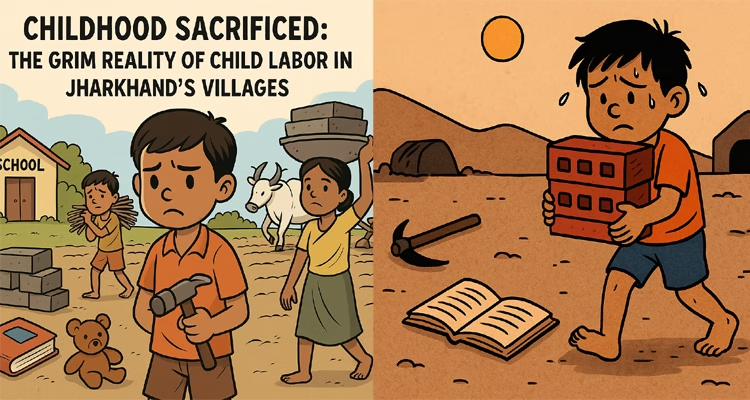
 Jharkhand, a land of abundant minerals and natural beauty, hides beneath its green canopy a silent crisis—rampant child labor that robs thousands of children of their childhood. As the world observes World Day Against Child Labor on June 12, the stark contrast between ideals and reality becomes painfully clear: while children should be playing and learning, many in Jharkhand’s rural heartlands are burdened with bricks, tools, and poverty.
Jharkhand, a land of abundant minerals and natural beauty, hides beneath its green canopy a silent crisis—rampant child labor that robs thousands of children of their childhood. As the world observes World Day Against Child Labor on June 12, the stark contrast between ideals and reality becomes painfully clear: while children should be playing and learning, many in Jharkhand’s rural heartlands are burdened with bricks, tools, and poverty.
In the remote villages of Jharkhand, childhood is not a phase of joy but of survival. The issue of child labor here is not merely economic—it is a complex interplay of deep-rooted poverty, social indifference, educational neglect, and administrative failure. At an age when children should be rushing to school, many wake before sunrise to collect firewood, till fields, or work in hazardous environments.
Poverty and Broken Promises
The core driver of child labor in these regions is extreme economic insecurity. Most families in Jharkhand’s villages live on subsistence income. Survival often means that every family member—including children—must contribute. Kids are sent to work in agriculture, livestock care, or forest collection activities. In many cases, it’s the parents themselves who push their children into labor—not by choice, but by compulsion.
While the Right to Education Act guarantees free and compulsory schooling for children aged 6 to 14, in reality, this law rarely translates into action. A lack of teachers, inadequate infrastructure, distant schools, and poor implementation of welfare schemes like the Mid-Day Meal drive children away from classrooms and toward labor. When education is neither accessible nor appealing, labor becomes their default path.
A Socially Accepted Crime
In many areas, child labor is not seen as a violation—it is normalized. Pervasive beliefs such as “children should learn to work early” still dominate village mindsets. It is common to see children working in fields, carrying bundles of wood, or toiling in brick kilns. This normalization is perhaps the most dangerous aspect—when injustice is perceived as normal, resistance becomes nearly impossible.
Jharkhand’s vast mineral wealth—coal, bauxite, iron ore—has not benefited its children. Instead, it has made them more vulnerable. Child labor is rampant in villages near mining zones. Children are found working in hazardous conditions—in coal mines, stone quarries, and kilns—exposed to toxic fumes, unsafe work, and physical exploitation. Multiple government and independent reports have confirmed this grim reality.
No Voice, No Resistance
There is little organized resistance to child labor in Jharkhand’s villages. Panchayats, community leaders, and even civil society organizations often ignore the issue. Gram Sabhas rarely discuss children’s rights, dropout rates, or the condition of schools. As long as child labor remains a “private family issue” instead of being treated as a societal crime, change will remain elusive.
Worse still, awareness of child rights and protection laws is virtually absent in these areas. Most parents and children are unaware of their rights, and information in local languages is scarce.
The Way Forward: Community-Led Change
To break this cycle, panchayat representatives must take a stand. Gram Sabhas should adopt resolutions against child labor, identify out-of-school children, and work with families. Government-formed Village Child Protection Committees—currently dormant—must be reactivated. Schools must become not only places of learning but also protectors of child rights. Teachers, if trained and alert, can spot and support child laborers, reintegrating them into education.
Initiatives like ‘School Chalo Abhiyan’, ‘Bal Sabha’, and the Mid-Day Meal Scheme need revitalization. This requires regular administrative oversight, resource allocation, and committed teacher training. Village elders, women’s groups, Anganwadi workers, and NGOs all have critical roles to play. When community leadership awakens, government machinery responds.
Hope Through Awareness and Enforcement
Change must begin with awareness. Village-level campaigns using street plays, child panchayats, and workshops can powerfully convey the message that child labor not only destroys futures—it hinders the progress of entire communities. Schools must be made attractive and accessible: consistent teacher attendance, engaging pedagogy, and a safe, child-friendly atmosphere are essential.
The ‘Child-Friendly Village’ model—where panchayats, schools, and local society ensure that no child works—can serve as a powerful blueprint. Additionally, proper implementation of social welfare schemes such as MNREGA, PDS rations, and student scholarships can ease economic pressures, giving families the breathing room to prioritize education over labor.
The Law Must Speak Loud and Clear
Laws like the Child Labor (Prohibition and Regulation) Amendment Act, 2016 exist, but enforcement is weak. Local administrations must carry out regular inspections and penalize violators. Laws are only as effective as their implementation—and in rural Jharkhand, that remains the final frontier.
Child labor in Jharkhand is not just a tragedy for individual children—it is a mirror reflecting a collective societal failure. In a state where the soil is rich with minerals, it is shameful that the surface remains barren of opportunity and safety for its youngest citizens. The silence of panchayats, the indifference of schools, and the normalization of exploitation have made child labor an accepted reality.
But change is possible.
If communities rise, if schools take responsibility, and if society declares that no child should ever work again, Jharkhand’s lost childhood can be reclaimed. Child labor is not an unfortunate consequence—it is a crime. And the most powerful weapon against this crime is an aware and united society.
Let every village pledge: “Our children will not work—they will learn, grow, and smile.”
(Written by : – Mithlesh Das, Research Scholar, Hindi Department, Radha Govind University, Ramgarh, Jharkhand)



